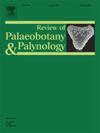A new Ephedra macrofossil from the Early Cretaceous Yixian Formation, Liaoning Province, China and its evolutionary significance
IF 1.7
3区 地球科学
Q2 PALEONTOLOGY
引用次数: 0
Abstract
Despite the significance of Gnetales in understanding the origin and evolution of seed plants, the morphological diversity of ancestral forms within this group remains unclear, and the evolutionary processes affecting their vegetative and reproductive structures lack robust evidence. In this study, we describe a new ephedroid macrofossil from the Lower Cretaceous Yixian Formation in western Liaoning, China. This species is characterized by decussate phyllotaxy, internodes with fine longitudinal striations, swollen nodes, and female cones featuring paired bracts and one to two seeds. While these characteristics resembled extant Ephedra, there are notable morphological differences, including oppositely branched stems of equal length and a seed envelope with transversely aligned epidermal cells on its surface. Consequently, we designate this new macrofossil reproductive shoot as a new species, Ephedra transversa sp. nov.. The findings of this study support the reduction and sterilization hypothesis and enhance our understanding of the evolutionary processes within Gnetales.
辽宁省早白垩世义县组麻黄大化石新发现及其演化意义
尽管麻属植物在了解种子植物的起源和进化方面具有重要意义,但该类群中祖先形态的多样性仍不清楚,影响其营养和生殖结构的进化过程缺乏有力的证据。本文描述了在辽西地区下白垩统义县组发现的一种新的麻黄类大化石。本种的特征是层状花序,节间有细的纵向条纹,肿胀的节,和雌花球果具有成对的苞片和一到两个种子。虽然这些特征与现存麻黄相似,但在形态上有显著的差异,包括茎长相等的相反分枝和表面有横向排列的表皮细胞的种皮。因此,我们将这一新的大化石生殖枝命名为新种:Ephedra transversa sp. nov。本研究结果支持了还原和灭菌假说,增强了我们对线虫进化过程的理解。
本文章由计算机程序翻译,如有差异,请以英文原文为准。
求助全文
约1分钟内获得全文
求助全文
来源期刊
CiteScore
3.50
自引率
21.10%
发文量
149
审稿时长
6 months
期刊介绍:
The Review of Palaeobotany and Palynology is an international journal for articles in all fields of palaeobotany and palynology dealing with all groups, ranging from marine palynomorphs to higher land plants. Original contributions and comprehensive review papers should appeal to an international audience. Typical topics include but are not restricted to systematics, evolution, palaeobiology, palaeoecology, biostratigraphy, biochronology, palaeoclimatology, paleogeography, taphonomy, palaeoenvironmental reconstructions, vegetation history, and practical applications of palaeobotany and palynology, e.g. in coal and petroleum geology and archaeology. The journal especially encourages the publication of articles in which palaeobotany and palynology are applied for solving fundamental geological and biological problems as well as innovative and interdisciplinary approaches.

 求助内容:
求助内容: 应助结果提醒方式:
应助结果提醒方式:


